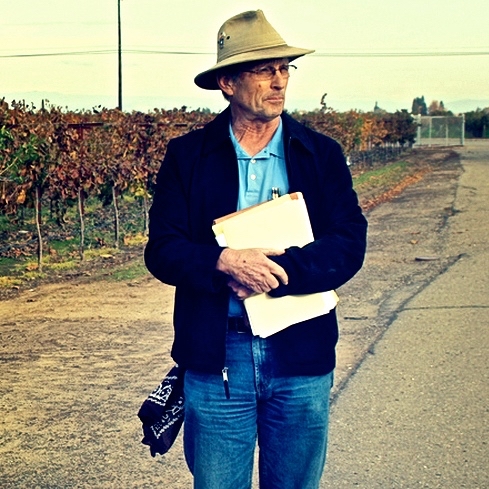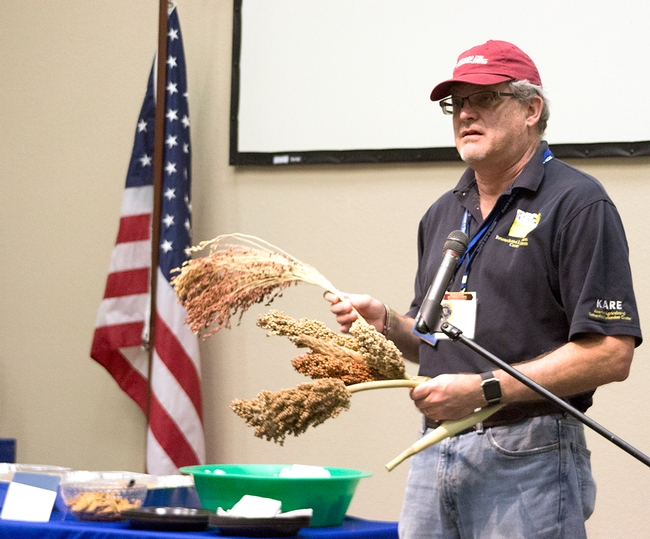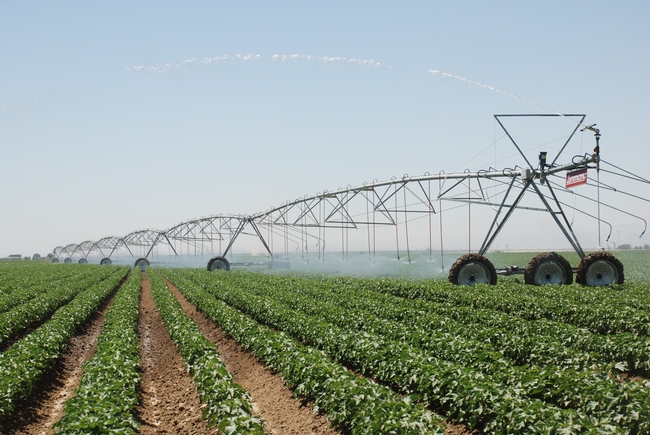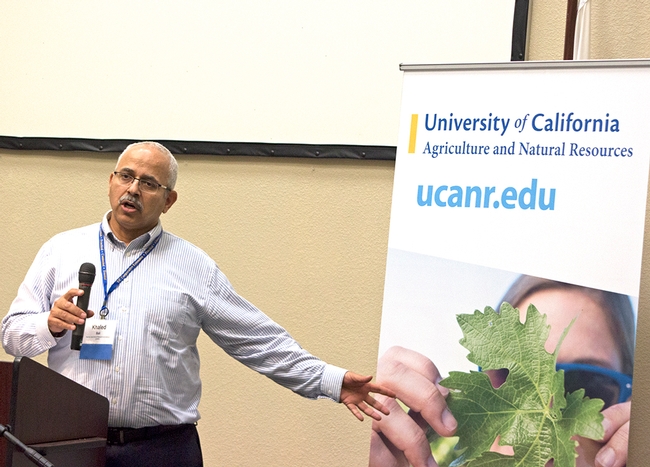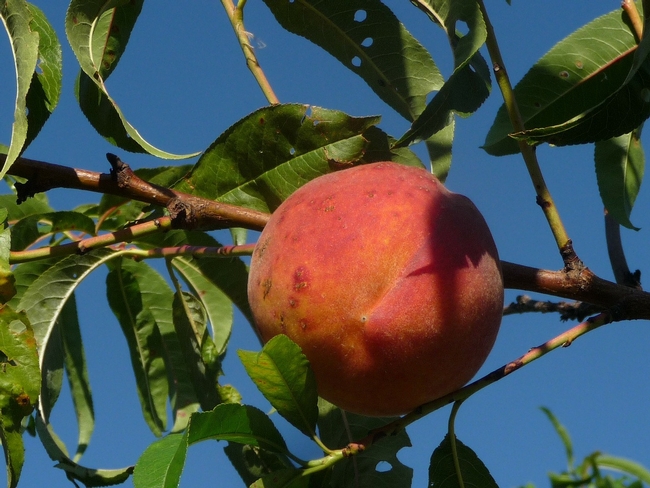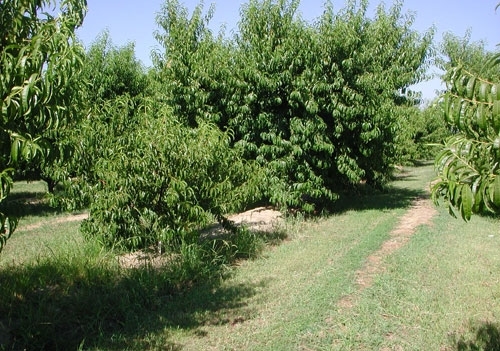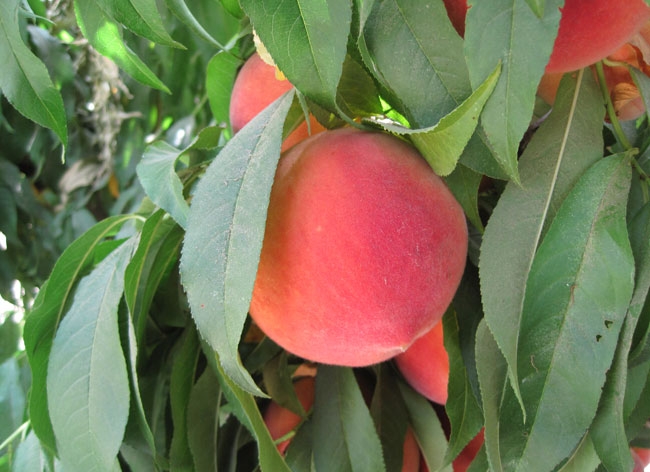Posts Tagged: Kevin Day
Monthly news round up: January 2018
Woodland as ag hub topic of forum
(Woodland Daily Democrat) Jenice Tupolo, Jan. 30
Developing Woodland as an agricultural center is becoming more of a reality, even as local organizations worked together in creating a forum focused on agricultural innovation in Yolo County.
...The city of Woodland, AgStart, UC Agricultural and Natural Resources, and the city's Food Front initiative hosted keynote speaker and vice president of the UC ANR, Glenda Humiston, at the conference.
http://www.dailydemocrat.com/business/20180130/woodland-as-ag-hub-topic-of-forum
Small Farmers in Fresno Hope for Big Moringa Payoff
(KQED) Katrina Schwartz, Jan. 26
The Mouas, along with other Hmong farmers growing moringa, have been working with farm advisers at Fresno County's UC Cooperative Extension to learn how to dry, powder and store their moringa so they can expand into new markets. Most farmers sell it fresh, but most of the health food craze exists around moringa powder, often imported from India.
… “Value-added products are a great way for a small family farm to increase their income,” said Ruth Dahlquist-Willard, a small-farm adviser with the program. Many farmers are accustomed to only selling fresh produce. They plant a diverse set of crops in a small area and sell a little bit of everything. Producing a product that requires the extra step of drying, grinding and storing is a whole new world for many of them.
“I think there's a lot of opportunity there,” Dahlquist-Willard said. She's particularly excited about how a product might bring the younger generation back to their family farms. Kids who have gone off to college for business, marketing or graphic design might see a new kind of future for themselves on the family farm with a product like moringa.
https://ww2.kqed.org/news/2018/01/26/small-farmers-in-fresno-hope-for-big-moringa-payoff/
SLO County's Top 20 Under 40: Meet the 2017 award winners
(San Luis Obispo Tribune) Staff, Jan. 26
…Katherine E. Soule, 35, is director of the UC Cooperative Extension for SLO and Santa Barbara counties, where she's earned state and national recognition for improving community health and increasing diversity in youth participation.
As the extension's youth, families and communities advisor for the last several years, Soule developed new 4-H programs engaging underserved youths and promoting healthy living, leadership and social development. Her efforts nearly doubled enrollment and boosted Latino participation 26.8 percent. She's delivered nutrition education to more than 10,000 people through various partnerships.
http://www.sanluisobispo.com/news/business/article196536784.html
Flooding alfalfa for groundwater recharge
(Morning Ag Clips) Jan. 24
A rigorous field study in two California climate zones has found that alfalfa can tolerate very heavy winter flooding for groundwater recharge. The research was published online Jan. 16 in California Agriculture journal.
The alfalfa research is the latest in a series of projects studying the effects of using land planted with permanent crops – including almond orchards and vineyards – to capture and bank winter storm water. Such projects have great promise but also require collaboration across multiple jurisdictions and agencies. UC Agriculture and Natural Resources vice president Glenda Humiston has made groundwater recharge on working lands and open spaces a division priority and is working with water and land use leaders around the state to facilitate it through policy recommendations and cross-agency collaboration.
https://www.morningagclips.com/flooding-alfalfa-for-groundwater-recharge/
Band Canker Affecting Younger Almonds
(California Ag Today) Patrick Cavanaugh, Jan. 24
Brent Holtz is a UC cooperative extension Pomology Farm Advisor for San Joaquin County. He recently told California Ag Today about how the fungus band canker on almonds is becoming more prevalent in the San Joaquin Valley.
“I've seen a lot more band canker, which is caused by a pathogenic fungus, Botryosphaeria dothidea, and we're seeing it on young orchards, especially in in San Joaquin county," said Holtz. "We've seen that a lot out in the delta and we've seen it in eastern San Joaquin county where the soils tend to be a little heavier, maybe old dairy ground and richer and we don't really know why."
https://californiaagtoday.com/band-canker-affecting-younger-almonds/
CCOF Annual Conference to Focus on Organic Hotspots
AgNet West) Jan. 22
Registration is available for the California Certified Organic Farmers (CCOF) annual conference, Organic Hotspots: Revitalizing Rural America. The event is scheduled for February 22 and 23 at the Sheraton Grand Sacramento Hotel in Sacramento.…
The event will focus on organic hotspots and how rural economies can potentially be stimulated by organic production. Topics will include partnerships between elected officials and the organic community, the role of education and research, along with the process of growing organic produce in local communities. The event will conclude with a keynote speech from Glenda Humiston, Vice President of the University of California Division of Agriculture and Natural Resources.
http://agnetwest.com/ccof-annual-conference-organic-hotspots/
California Today: 100 Million Dead Trees Prompt Fears of Giant Wildfires
(New York Times) Thomas Fuller, Jan. 19
The more than 100 million trees that died in California after being weakened by drought and insect infestations have transformed large swaths of the Sierra Nevada into browned-out tree cemeteries. In some areas more than 90 percent of trees are dead.
This week a group of scientists warned in the journal BioScience that the dead trees could produce wildfires on a scale and of an intensity that California has never seen.
…“It's something that is going to be much more severe,” said Scott Stephens, a professor of fire science at Berkeley and the lead author of the study. “You could have higher amounts of embers coming into home areas, starting more fires.”
Winter's good time for gopher control in nut crops
(Western Farm Press) Cecelia Parsons, Jan. 17, 2018
Tree nut growers who are plagued by gopher invasions in their orchards need to stick with effective control measures if they want to minimize tree losses.
Pocket gophers are common in most nut production areas, says Joe Connell, University of California Cooperative Extension Farm Advisor Emeritus in Butte County. In the absence of cover crops or weeds, they will gnaw on tree roots and trunks, and the hungry vertebrate pests can even girdle — and kill — older trees. Trees with root damage and girdling will lose production, and will be susceptible to crown gall, which weakens their structural strength.
http://www.westernfarmpress.com/tree-nuts/winter-s-good-time-gopher-control-nut-crops
Bloomington nursery's citrus trees to be destroyed by California agriculture department
(ABC7 KABC) Rob McMillan, Jan. 17, 2018
Roxana Vallejo was 12 years old when her parents opened up Santa Ana Nursery in Bloomington. Wednesday, the California Department of Food and Agriculture will be at her business to destroy almost all of their citrus trees. Vallejo said the combined value of the trees is almost $1 million.
"They're all fine, and look at all the new growth, it's pretty good," Vallejo said.
The reason they're being cut down is huanglongbing, or HLB, one of the world's worst citrus diseases. The insect that spreads HLB has taken a strong foothold in Southern California.
"It's estimated that the citrus industry may go commercially extinct unless they can get a handle on this problem," said Mark Hoddle, UC Cooperative Extension specialist at UC Riverside, more than one year ago.
http://abc7.com/food/ie-nurserys-citrus-trees-to-be-destroyed-by-ca-agriculture-department/2959173/
OPINION: Ranchers give thanks
(Ventura County Star) Beverly Bigger, president of the Ventura County Cattlemen's Association, Jan. 16, 2018
The majority of attention and sympathy have rightly gone toward those who lost their homes in the Thomas Fire, but I would like to take a moment to highlight the story of others who have suffered as well. They are largely invisible, hidden among the hills and canyons, but their contribution to the county is significant.
Ventura County is home to a robust and historic cattle industry, one that makes up a $2 million portion of Ventura County's agricultural sector. Ranchers play an important role in land management as well, their grazing operations clearing overgrown brush, reducing the fuel available to wildfires and protecting nearby communities.
In the space of 12 hours, the Thomas Fire ripped through vital grazing land that cattle rely on for their daily feed. Sadly, some animals were also lost to the fire.
With feed and fencing gone, many ranchers had hard decisions to make regarding the future of their operations, and some were not prepared for this kind of disaster. Thankfully, we have dedicated public servants who stepped up to help the cattle industry.
Ventura County Agricultural Commissioner Henry Gonzales, Matthew Shapero from the UC Cooperative Extension, and Donna Gillesby and Bryan Bray of Ventura County Animal Services all reached out to ask what they could do to help.
An emergency program was put in place to supply five days of hay until ranchers could get on their feet. The UC Extension also provided a one-stop location where ranchers could meet with representatives from multiple agencies to apply for assistance programs.
The assistance of these agencies was very much appreciated. We want to thank and recognize them for helping us in our time of need. We look forward to returning to our passion: managing and improving the land and continuing Ventura County's ranching heritage.
http://www.vcstar.com/story/opinion/readers/2018/01/16/ranchers-give-thanks/1038625001/
Farm advisor tests strategies for controlling horseweed
(Ag Alert) Bob Johnson, Jan. 10, 2018
One morning last summer, University of California Cooperative Extension vineyard weed control advisor John Roncoroni displayed a horseweed plant that had grown to more than 10 feet tall in a Yolo County vineyard.
Horseweed, which is widely seen on the sides of the state's highways, is among the glyphosate-resistant weed pests that can develop healthy populations in even well managed vineyards.
"We're really having problems with weeds coming in the fall that are resistant to Roundup," Roncoroni said. "Willow herb is tolerant; it's never been completely controlled by glyphosate."
http://www.agalert.com/story/?id=11460
Pomegranate returns not so wonderful but largest grower says otherwise
(Hanford Sentinel) By John Lindt, Jan. 11, 2018
A few years ago Central Valley pomegranate growers appeared to be riding a rising tide of popularity for pomegranates spurring optimism about the crop's future. Growers, including those in Kings County, enjoyed prices of over $1,700 a ton as recently as 2011.
After a significant planting of new trees, by 2015 pomegranate tonnage was fetching just $450 a ton in Fresno County and falling to $362 a ton in Tulare County according to its 2016 crop report.
…UC Farm Adviser Kevin Day says it's simple economics. “We are seeing both overproduction and lack of demand for pomegranates despite expectations to the contrary."
Western Innovator: Promoting sustainable ranching
(Western Farm Press) Tim Hearden, Jan. 9, 2018
Tracy Schohr has devoted much of her career to promoting sustainability in ranching.
While at the California Cattlemen's Association, she put on an annual “rangeland summit” that brought ranchers together with environmental experts and climate change policymakers.
She also worked on a program to limit ranchers' risk of facing Endangered Species Act violations if they created habitat on their land.
After going back to school to earn her master's degree at the University of California-Davis, Schohr has become a UC Cooperative Extension livestock and natural resources adviser based in Plumas, Sierra and Butte counties. http://www.capitalpress.com/California/20180108/western-innovator-promoting-sustainable-ranching
Weed Control with Brad Hanson UC Cooperative Extension Weed Specialist at UC Davis
(California Ag Today) Patrick Cavanaugh, Jan. 8, 2018
“Weeds are probably one of the year-in, year-out problems that growers face,” said Brad Hanson, UC Cooperative Extension, who discussed herbicide resistance with California Ag Today.
Building blocks for tending flocks
(Auburn Journal) Julie Miller, Jan. 7, 2018
Counting sheep is no longer for the tired and sleepy.
Shepherding has become a booming industry in Placer County. At last count, there are 9,000 head of sheep registered with the county, said Dan Macon, livestock and natural resources advisor for University of California, for Placer and Nevada counties. And there may be more sheep that have not been registered, perhaps because they are in a smaller flock of 10 to 15, he said.
Sheep have proven to be versatile. Not only raised for the meat and milk, but also wool fibers, plus, they can help reduce fire danger by eating away tall grasses and shrubs.
http://www.auburnjournal.com/article/1/06/18/building-blocks-tending-flocks#
After a recent outbreak of E.coli, is it safe to eat romaine lettuce? Experts differ
(Fresno Bee) Robert Rodriguez, Jan. 5, 2018
If you are staying away from romaine lettuce because of an outbreak of E.coli, it's understandable. But at least one food safety expert says it may not be necessary.
…But University of California food safety expert Trevor Suslow said it's unlikely the lettuce you buy at the grocery store these days is going to do you any harm. That's because the illnesses happened from Nov. 15 through Dec. 8. Lettuce sold during that period wouldn't be around anymore.
“It's not going to last that long, it's gone,” Suslow said.
http://www.fresnobee.com/living/food-drink/article193301924.html
Cattle Ranchers Join Conservationists To Save Endangered Species And Rangelands
(Forbes) Diana Hembree, Jan. 5, 2018
…California has a strong incentive to preserve its 18 million acres of ranchland: Cattle and calves are the state's fourth-leading agricultural commodities (milk and cream are No. 1), according to state agricultural data. But in a Duke University survey of the state's ranchers, more than half said they were “more uncertain than ever” that they would be able to continue ranching. California is losing an estimated 20,000 acres of rangeland each year, according to the Nature Conservancy, and on any given day ads for the sale of cattle ranches dot the Internet. The median age of California ranchers is 58 to 62, and more are aging out of the business with no children interested in taking over the ranch.
But this trend can be reversed, according to Lynn Huntsinger a professor of environmental science and rangeland ecology at UC Berkeley. To preserve these landscapes for future generations, ranchers need payment and recognition for their ecosystem services “in order to preserve these working landscapes for future generations,” Huntsinger writes.
Months after Wine Country fires, damaged vineyards face uncertainty
(SF Chronicle) Esther Mobley, Jan. 4
…“No one knows what's the real threshold for heat damage,” says Rhonda Smith, the Sonoma County-based viticulture farm adviser for the University of California, who has come to Gilfillan to consult on its rehabilitation.
Much of the conventional wisdom about how fires interact with vines — that vines can't burn, because of their high water content, for instance — didn't turn out to be true for every vineyard, she says.
“In 99 percent of cases, vines were fire breaks,” says Smith. But if there was dry vegetation, if there was wood mulch on the ground, if the soil was especially dry — if, if, if — then they weren't.
http://www.sfchronicle.com/wine/article/Months-after-Wine-Country-fires-damaged-12474309.php
Progress reported on robotic weeders for vegetables
(Ag Alert) Bob Johnson, Jan. 4
The next generation of computer-controlled, automated cultivators will be able to use cameras to remove weeds in the seed line as close as 1 inch from young tomato or lettuce plants, without damaging the crop.
…
“It must be more than half the lettuce acreage that is already using the automated thinners,” said Steve Fennimore, UC Cooperative Extension vegetable weed specialist.
Fennimore is supervising the Salinas lettuce trials of “marking” the crop in order to make this technology practical for weeding as well.
“The weeders already out there tend to be prototypes that people are still experimenting with,” he said.
http://www.dailydemocrat.com/article/NI/20180104/NEWS/180109957
2017's natural disasters cost American agriculture over $5 billion
(New Food Economy) Sam Bloch, Jan. 4, 2018
Over a period of 10 months in 2017, America experienced 16 separate, billion-dollar weather and climate-related disasters. Those weather events carved paths of destruction straight through some of the most fertile and productive regions of the country, wreaking havoc on beef cattle ranches in Texas, soaking cotton and rice farms in Louisiana, orange groves in Florida, and burning up vineyards in California. And that was all before Southern California's still-active Thomas fire, which began on December 4, and then closed in on the country's primary avocado farms. It's now the state's largest-ever, in terms of total acreage.
- Acres of cherimoya trees in Santa Barbara County destroyed by the Thomas fire: 100
- Total dollar value of Santa Barbara cherimoya fruit damaged by fire: $5,000,000
- Acres of avocado fields in Santa Barbara and Ventura Counties threatened by wildfire: 5,260
- Estimated pounds of Hass avocados in Ventura County lost to wildfire: 8,060,000
- Total dollar value of that lost harvest: $10,175,750
- Approximate percentage of American avocado crop threatened by wildfire: 8
- Expected effect of wildfire on avocado prices in America, due to reliance on imports: 0
- Winegrape acreage in Napa and Sonoma Counties: 104,847
- As a percentage of total California winegrape acreage: 22
- Estimated dollar value of unharvested Cabernet grapes in those counties, before the wildfires: $175,000,000
- Estimated dollar value of those grapes, now tainted by smoke: $29,000,000
- Bottles of 2016 Napa Cabernet you can buy for the price of two 2017 vintages, due to winegrape scarcity: 3
California wildfire data from Daniel A. Sumner, Ph.D. of UC Agricultural Issues Center, USDA NASS, Ben Faber, Ph.D. of UC Cooperative Extension Ventura.
https://newfoodeconomy.org/2017-natural-disasters-agriculture-damage-5-billion/
There Is No “No-Fire” Option in California
(Bay Nature) Zach St. George, Jan. 2, 2018
As the use of prescribed fire by Cal Fire declined in recent decades, its use also declined with private landholders, says Lenya Quinn-Davidson, director of the Northern California Prescribed Fire Council, who leads prescribed burning workshops across the state. Scott Stephens, the UC Berkeley professor, concurs. Decades of suppression left the western U.S. with relatively few people trained to carry out the work: “We just don't have that experience to pass on.” But it's important not to let the current enthusiasm pass, he says—as climate change continues to push conditions toward extremes, as wildfires consume more and more of fire agency budgets, and as the wildland-urban interface expands, it will only become more difficult to bring fire back.
https://baynature.org/article/no-no-fire-option-california/
Scientist discusses working on Food Evolution movie
(Brownfield Ag News) Larry Lee, Jan. 1
A scientist involved in a movie about genetically modified food says many don't understand what GM is, let alone the benefits. Alison VanEenennaam says, “Really, it's a breeding method, and I think the public sector applications for things like disease resistance have very compelling societal benefits that I think most people can relate to. I don't think we want plants and animals getting sick, and if we can solve that problem genetically rather than using chemicals, I think people get that.”
VanEenennaam is a geneticist at the University of California. She tells Brownfield there is a lot of unnecessary fear about eating genetically modified food. “The safety around GM (Genetically Modified) has been established and is, you know, agreed on by every major scientific society in the world and yet we've got the vast majority of consumers that don't believe that.”
https://brownfieldagnews.com/news/scientist-discusses-working-food-evolution-movie/
Urban Edge farm program offers immersion-style learning
(East Bay Times) Lou Fancher, Jan. 1, 2018
After operating a pilot version of the ambitious program, a $200,000 grant from the USDA National Institute of Food and Agriculture's Beginning Farmer and Rancher Development Program is a launch pad for the immersive learning experience.
For the first cohort of students, many of them women and/or people of color, immigrants, refugees, veterans or farmers-to-be with limited resources, the land is a classroom. Instruction comes from First Generation and experts from the National Center for Appropriate Technology and UC Cooperative Extension. Participation in the program represents opportunity and fulfills dreams the first-time farmers hold of agricultural avocation, economic stability, families, homesteads and permanence.
https://www.eastbaytimes.com/2018/01/01/urban-edge-farm-program-offers-immersion-style-learning/
Tribute to Paul Verdegaal – one of Lodi's “men behind the curtain”
(Lodi Wine blog) Randy Caparoso, Jan. 1, 2018
This coming February 6, 2018, Lodi winegrowers will get together for their 66th Annual LODI GRAPE DAY. They will also mark the occasion with a celebration of the retirement of Paul Verdegaal, who has been working full-time as San Joaquin County's viticulture, bush berry and almond Farm Advisor under the auspices of UCCE (University of California Cooperative Extension) since 1986.
http://www.lodiwine.com/blog/Tribute-to-Paul-Verdegaal---one-of-Lodi-s--men-behind-the-curtain-
The drought may be over, but water concerns haven't been doused
Record winter rainfall during the 2016-17 winter has enabled farms to emerge from survival mode in the short term, but scientists are still working hard to be ready for the next drought, reported Tim Hearden in Capital Press.
Hearden spent a day at the UC Kearney Agricultural Research and Extension Center in Parlier to learn how researchers at the facility and the UC West Side Research and Extension Center near Five Points are combining technology with management practices to put every drop of irrigation water to work.
“This is one of the few places in the world where you can do drought research on a field level,” said Jeff Dahlberg, director of the 330-acre Kearney facility. “What I'm planning is a world-class drought nursery.”
At the West Side REC, researchers are working with farmers to perfect micro-irrigation efficiency and test drought stress on the area's most prevalent crops.
“We'll grow a tremendous number of cultivars of a crop” and identify “what seem to be the most promising cultivars when you grow them under drought conditions,” said Bob Hutmacher, a cotton specialist and the center's director.
Hearden spoke to Jeff Mitchell, UCCE cropping systems specialist and director of the Conservation Agriculture Systems Innovation center (CASI). CASI is encouraging farmers to adopt farming practices that save water, reduce dust and help improve the condition of soil, such as subsurface drip irrigation, overhead irrigation, minimum tillage, cover crops and crop residues.
“This is not done right now in California,” Mitchell said. “In the future, there may be a strong likelihood of certain agricultural sectors adopting these practices.”
Other subsurface irrigation trials are showing dramatic increases in yields. Khaled Bali, an irrigation water management specialist at Kearney, said underground drip systems in alfalfa fields have achieved 20 to 30 percent more yields while in some cases using 20 percent less water.
Kevin Day, a UCCE pomology advisor in Tulare County, is trying subsurface drip in a peach and nectarine orchard after working with the USDA to use it for pomegranates. He's seen as much as a 90 percent reduction in weeds because there's no surface water to feed them.
“Fewer weeds, fewer pesticides,” he said. “We use high-frequency irrigation. We irrigate as the crop needs it. When you do that, you keep the roots deeper, which makes for better aeration.”
California summer fruit smaller and tastier this year
"That smaller peach this year very likely is sweeter than the moderate-sized peach of last year," said Kevin Day, UC ANR Cooperative Extension advisor and director in Tulare and Kings counties.
Most of the change in fruit size can be attributed to the drought. When irrigation is limited, water content of the fruit diminishes and sugars become a greater proportion of the fruit mass. However, Day says drought isn't the only reason for 2015's smaller fruit size. California also had unusually warm temperatures in January and February 2015, causing fruit to ripen faster.
"A variety that might ripen after 120 days of being on a tree in a year like this ripens in only 110," Day said. "And, so it's consequently shortchanged out of 10 days of growing."
UC research on dwarf fruit trees featured on local news
Kevin Day, a UC Cooperative Extension farm advisor for Tulare County, has been comparing the quality of fruit on stone fruit trees pruned conventionally, in hedge rows and other configurations for 17 years. Now he and his colleague Ted DeJong, UCCE specialist in the Department of Plant Sciences at UC Davis, are taking a new look at small-sized trees, reported KSEE Channel 24 news in Fresno.
The idea is keeping the fruit trees short so ladders won't be necessary for harvest and other orchard operations, while at the same time maintaining excellent yield and fruit quality.
Day talked to the KSEE news crew in a peach and nectarine orchard at the UC Kearney Agricultural Research and Extension Center in Parlier.
"This is good news for farmers and farmworkers," said reporter Theresa Sardina. "This means safer working conditions for workers and less money out of farmers' pockets."
Day said the researchers are trying to better understand the labor savings aspect of small fruit trees, but he believes they will be proven to be significantly more cost effective.
"You can save a minimum of 25 if not up to 50 percent on any particular labor operations," Day said.
The lead agricultural technician at Kearney, Rudolfo Cisneros, was also interviewed for the story.
See the video on the KSEE Channel 24 website.
Ladderless peach and nectarine orchards explored
Can shorter peach and nectarine trees reduce labor costs without sacrificing fruit quality and yield?
The answer may be developing soon at a 4-acre test orchard south of Fresno, where University of California researchers are planting semi-dwarfing rootstocks as part of a large, integrated experiment on virtually every aspect of peach and nectarine production.
“We're designing ‘ladderless' orchards, which have the potential to cut labor costs by 50 percent or more and improve worker safety,” said UC Cooperative Extension specialist Ted DeJong, a plant physiology professor at UC Davis. DeJong and Kevin Day, a Cooperative Extension farm advisor in Tulare County, are leading the experiment.
Conventional peach and nectarine trees grow about 13 feet tall. Setting up, climbing and moving ladders to prune the trees and harvest fruit consumes about half the workday. Ladders are dangerous, too, which is why peach and nectarine growers pay about 40 percent more for workers' compensation insurance than growers who work with more low-lying commodities, like grapes.
Developed by breeders at UC Davis, the new rootstocks will produce trees that grow about 7 or 8 feet tall and can be pruned and harvested from the ground. With the right orchard management — which Day and DeJong will test at their plots at the UC Kearney Agricultural Research and Extension Center, near Fresno — the shorter trees could produce just as much high-quality fruit as their lofty kin.
“Ladderless orchards would be huge for our industry,” said Bill Chandler, who grows several varieties of peaches and nectarines on his 250-acre Chandler Farms in Selma, California. “There are so many costs associated with ladders that many growers are switching over to almonds just to stay in business. It costs me $1,400 an acre to thin our trees.”
Rod Milton, a fourth-generation stone-fruit grower, said he would welcome a ladderless system for the peaches and nectarines he grows in Reedley, California.
“Even with conventional rootstocks, I prune my trees so workers can take two fewer steps on the ladder come harvest time,” he said. “And the savings are huge, even with that. It's important to keep farm work safe. And it's important to keep farming viable, or else we'll be getting all our produce from overseas.”
Shorter trees are just one of the elements of DeJong's and Day's experiment, which explores best practices for keeping peach and nectarine production economically and environmentally sustainable. Funded by the UC Division of Agriculture and Natural Resources, their model orchard will integrate virtually every UC pomology advancement in the past 30 years.
The team will plant conventional, tall trees in one plot and cultivate them using standard irrigation, fertilization and pruning practices. On three other plots, they will grow shorter trees with new, “best-management” practices such as minimal pruning, using pressure chambers to measure a tree's water needs, and applying compost and nitrogen sprays to minimize nutrient leaching and groundwater contamination. They will compare fruit size and yields, canopy light interception, water and nitrate leaching, and more. Graduate students will have opportunities to get hands-on experience as the next generation of stone-fruit experts.
“We're excited to take our experiments to the next level, to provide growers what they need to make good management decisions,” Day said.
Growers are excited, too.
“If it wasn't for people like Ted DeJong and Kevin Day, I'm not sure there'd be any of us peach and nectarine growers left,” Chandler said. “They work so hard to make farming efficient.”
The team will begin planting in spring 2015 and should have preliminary data by 2016.




